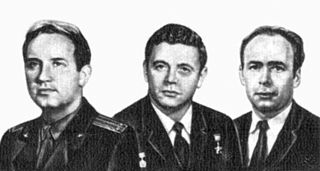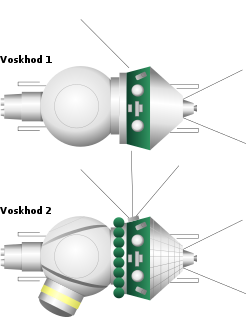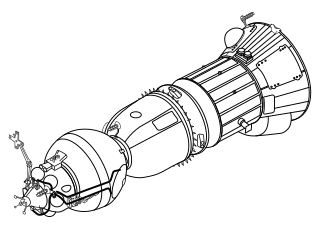
The Soyuz programme is a human spaceflight programme initiated by the Soviet Union in the early 1960s. The Soyuz spacecraft was originally part of a Moon landing project intended to put a Soviet cosmonaut on the Moon. It was the third Soviet human spaceflight programme after the Vostok and Voskhod programme.

Soyuz 1 was a manned spaceflight of the Soviet space program. Launched into orbit on 23 April 1967 carrying cosmonaut Colonel Vladimir Komarov, Soyuz 1 was the first crewed flight of the Soyuz spacecraft. The flight was plagued with technical issues, and Komarov was killed when the descent module crashed into the ground due to a parachute failure. This was the first in-flight fatality in the history of spaceflight.

Soyuz is a series of spacecraft designed for the Soviet space program by the Korolev Design Bureau in the 1960s that remains in service today. The Soyuz succeeded the Voskhod spacecraft and was originally built as part of the Soviet crewed lunar programs. The Soyuz spacecraft is launched on a Soyuz rocket, the most reliable launch vehicle in the world to date. The Soyuz rocket design is based on the Vostok launcher, which in turn was based on the 8K74 or R-7A Semyorka, a Soviet intercontinental ballistic missile. All Soyuz spacecraft are launched from the Baikonur Cosmodrome in Kazakhstan. Soyuz has served as the only means for crewed space flights in the world since the retirement of the US Space Shuttle in 2011 and is heavily used in the International Space Station program.
Soyuz 7K-T No.39, was an unsuccessful launch of a manned Soyuz spacecraft by the Soviet Union in 1975. The mission was expected to dock with the orbiting Salyut 4 space station, but due to a failure of the Soyuz launch vehicle the crew failed to make orbit. The crew consisted of commander Vasily Lazarev, and flight engineer Oleg Makarov, a civilian. Although the mission was aborted and did not accomplish its objective, the craft exceeded the Karman line altitude of 100 kilometers and therefore reached a suborbital spaceflight, which the crew survived. The crew, who initially feared they had landed in China, were successfully recovered.

Soyuz 11 was the only manned mission to board the world's first space station, Salyut 1. The crew, Georgy Dobrovolsky, Vladislav Volkov, and Viktor Patsayev, arrived at the space station on 7 June 1971 and departed on 29 June. The mission ended in disaster when the crew capsule depressurized during preparations for reentry, killing the three-man crew. The three crew members of Soyuz 11 are the only humans known to have died in space.

Salyut 1 (DOS-1) was the first space station of any kind, launched into low Earth orbit by the Soviet Union on April 19, 1971. The Salyut program followed this with five more successful launches of seven more stations. The final module of the program, Zvezda (DOS-8) became the core of the Russian segment of the International Space Station and remains in orbit.

Salyut 7 was a space station in low Earth orbit from April 1982 to February 1991. It was first manned in May 1982 with two crew via Soyuz T-5, and last visited in June 1986, by Soyuz T-15. Various crew and modules were used over its lifetime, including 12 manned and 15 unmanned launches in total. Supporting spacecraft included the Soyuz T, Progress, and TKS spacecraft.

The Vostok was a type of spacecraft built by the Soviet Union. The first human spaceflight was accomplished with Vostok 1 on April 12, 1961, by Soviet cosmonaut Yuri Gagarin.

The Voskhod was a spacecraft built by the Soviet Union's space program for human spaceflight as part of the Voskhod programme. It was a development of and a follow-on to the Vostok spacecraft. Voskhod 1 was used for a three-man flight whereas Voskhod 2 had a crew of two. They consisted of a spherical descent module, which housed the cosmonauts, and instruments, and a conical equipment module, which contained propellant and the engine system. Voskhod was superseded by the Soyuz spacecraft in 1967.

Gennadi Mikhailovich Strekalov was an engineer, cosmonaut, and administrator at Russian aerospace firm RSC Energia. He flew into space five times and lived aboard the Salyut-6, Salyut-7, and Mir space stations, spending over 268 days in space. The catastrophic explosion of a Soyuz rocket in 1983 led to him being one of only four people to use a launch escape system. He was decorated twice as Hero of the Soviet Union.

Vladimir Georgiyevich Titov is a retired Russian Air Force Colonel and former cosmonaut. He has participated in four spaceflight missions. The catastrophic explosion of a Soyuz rocket in 1983 led to him being one of only four people to use a launch escape system. He is married to Alexandra Kozlova, they have two children.
Soyuz T-8 was a manned mission to the Salyut 7 space station in 1983. Shortly into the mission, the spacecraft failed to dock with the space station due to an incident involving an antenna being torn off the craft by the protective launch shroud. After a fuel-consuming attempt made in darkness for an optical rendezvous with Salyut 7 resulted in an abort in order to avoid collision, it was decided to de-orbit T-8 two days into the mission in order to ensure that the spacecraft had a sufficient amount of propellant for the de-orbit maneuver. After de-orbiting, landing of the craft occurred normally.

A launch escape system (LES) or launch abort system (LAS) is a crew safety system connected to a space capsule, used to quickly separate the capsule from its launch vehicle rocket in case of a launch abort emergency, such as an impending explosion. The LES is typically controlled by a combination of automatic rocket failure detection, and a manual activation for the crew commander's use. The LES may be used while the launch vehicle is still on the launch pad, or during its ascent. Such systems are usually of two types:

The Soyuz-U launch vehicle was an improved version of the original Soyuz rocket. Soyuz-U was part of the R-7 family of rockets based on the R-7 Semyorka missile. Members of this rocket family were designed by the TsSKB design bureau and constructed at the Progress Factory in Samara, Russia. The first Soyuz-U flight took place on 18 May 1973, carrying as its payload Kosmos 559, a Zenit military surveillance satellite. The final flight of a Soyuz-U rocket took place on February 22, 2017, carrying Progress MS-05 to the International Space Station.

The Soyuz 7K-LOK, or simply LOK was a Soviet crewed spacecraft designed to launch men from Earth to orbit the Moon, developed in parallel to the 7K-L1. The LOK would carry two cosmonauts, acting as a mother ship for the LK Lander which would land one crew member to the surface. It was part of the N1-L3 programme which also included the LK lander and the N1 rocket.

Soyuz TMA-19 was a manned spaceflight to the International Space Station and is part of the Soyuz programme. It was launched June 15, 2010 carrying three members of the Expedition 24 crew to the International Space Station, who remained aboard the station for around six months. TMA-19 was the 106th manned flight of a Soyuz spacecraft, since the first mission which was launched in 1967. The spacecraft remained docked to the space station for the remainder of Expedition 24, and for Expedition 25, to serve as an emergency escape vehicle. It undocked from ISS and landed in Kazakhstan on the November 26, 2010. It was the 100th mission to be conducted as part of the International Space Station programme since assembly began in 1998.

Soyuz TMA-06M launched on 23 October 2012 was a spaceflight to the International Space Station, transporting three members of the Expedition 33 crew. TMA-06M was the 115th flight of a Soyuz spacecraft, the first flight launching in 1967. Soyuz TMA-06M launch was also the first manned flight from the remote Site 31 pad since July 1984.
Soyuz 7K-OK No.1 was an uncrewed spacecraft of the Soyuz programme, originally intended to perform a rendezvous maneouvre with Kosmos 133. After the Kosmos 133 mission failed, the rocket was moved to the launch pad on 12 December 1966 and scheduled to launch on 14 December 1966, 1:00 pm Moscow Time.

In the event of catastrophic failure, the Soyuz spacecraft has a series of automated and semi-automated abort modes to rescue the crew. The abort systems have been refined since the first manned flights and all abort scenarios for the Soyuz MS are expected to be survivable for the crew.

Soyuz MS-10 was a crewed Soyuz MS spaceflight which aborted shortly after launch on 11 October 2018 due to a failure of the Soyuz-FG launch vehicle boosters. MS-10 was the 139th flight of a Soyuz spacecraft. It was intended to transport two members of the Expedition 57 crew to the International Space Station. A few minutes after liftoff, the craft went into contingency abort due to a booster failure and had to return to Earth. By the time the contingency abort was declared, the launch escape system (LES) tower had already been ejected and the capsule was pulled away from the rocket using the launch escape solid rocket motors on the capsule fairing. Both crew members, Roscosmos cosmonaut Aleksey Ovchinin and NASA astronaut Nick Hague, were recovered alive and in good health. The MS-10 flight abort was the first instance of a Russian manned booster accident in 35 years, since Soyuz T-10-1 exploded on the launch pad in September 1983. On 1 November 2018, Russian scientists released a video recording of the mission.


















